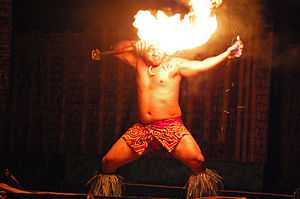Fire knife

The fire knife is a traditional Samoan cultural implement that is used in ceremonial dances. It was originally composed of a machete wrapped in towels on both ends with a portion of the blade exposed in the middle. Tribal performers of fire knife dancing (or Siva Afi as it is called in Samoa) dance while twirling the knife and doing other acrobatic stunts. The towels are set afire during the dances thus explaining the name.
History
Knife dancing has a history which goes back hundreds of years. The modern fire knife dance has its roots in the ancient Samoan exhibition called "ailao" - the flashy demonstration of a Samoan warrior's battle prowess through artful twirling, throwing and catching, and dancing with a war club. The 'ailao could be performed with any warclub and some colonial accounts confirm that women also performed 'ailao at the head of ceremonial processions, especially daughters of high chiefs. During night dances torches were often twirled and swung about by dancers, although a warclub was the usual implement used for 'ailao. Before the introduction of metals, the most common clubs that were wielded and displayed in the 'ailao fashion were elaborately carved heirloom clubs called "anava." These 'anava were frequently carved with serrated edges and jagged "teeth" which characterized the unique Samoan weapon called the "nifo'oti." When European and American whalers and traders began commercial ventures in Samoa they introduced the natives to the long-handled blubber knife and the hooked cane knife. The characteristic metal hook of these tools was readily incorporated into the Samoan wooden nifo'oti which bears the unique hooked element whether carved from wood or forged from steel. One common claim is that the word "nifo'oti" means "tooth of death" but this is not linguistically accurate as Samoan syntax places the modifier after the subject; according to Samoan grammar the term "nifo'oti" would actually mean "dead tooth," hardly as intimidating as the former translation. One more linguistic issue remains to be worked out in regards to 'oti (with the initial glottal stop) and "oti" (without the glottal stop). When pronounced with the glottal stop, the word 'oti does not mean "death" at all; as a verb, 'oti means "to cut" as in 'otiulu ("hair cut") or as a noun it refers to the domestic goat. Therefore the most probable derivation of the term "nifo'oti" stems from the resemblance of the weapon's hook to the curved horn ("nifo) of a goat ('oti), or from the serrated teeth ("nifo") that formed the weapon's cutting edge ('oti).
Fire was added to the knife in 1946 by a Samoan knife dancer named Freddie Letuli, later to become Paramount Chief Letuli Olo Misilagi. Letuli was performing in San Francisco and noticed a Hindu Fire eater and a little girl with lighted batons. The fire eater loaned him some fuel, he wrapped some towels around his knife, and the fire knife dance was born.
Although today many commercial performers perform the dance with short staffs or unbladed knives, this is not authentic fire knife dance and is unacceptable in the Samoas except for training purposes. The knives used by performers in American Samoa are still made of machetes, although they are often dulled for younger dancers.
Competition
Traditional competitions were hotly contested. Their exhibitionists would almost rather die than seek medical care for injuries incurred while performing.[citation needed] Today, modern competitions are held annually at the Polynesian Cultural Center to name the World Fireknife Champion. The competition began in 1992 and is always held during the third week of May. In 2007, the championships were expanded to welcome competitors in a duet category and a women's category. In 2010 the event expanded to four nights including a two night, three person final competition.
Champions by year are:
- 2013: Joseph Cadousteau (Papeete, Tahiti)
- 2012: Joseph Cadousteau (Papeete, Tahiti)
- 2011: Viavia Tiumalu, Jr. (Orlando, Florida)
- 2010: Mikaele Oloa (Waialua, Hawaii)
- 2009: Mikaele Oloa (Waialua, Hawaii)
- 2008: Viavia Tiumalu, Jr. (Orlando, Florida)
- 2007: Andrew "Umi" Sexton (Orlando, Florida)
- 2006: Mikaele Oloa (Orlando, Florida)
- 2005: Mikaele Oloa (Orlando, Florida)
- 2004: Alex Galeai (Laie, Hawaii)
- 2003: David Galeai (Cook Islands)
- 2002: Pati Levasa (Samoa)
- 2001: Pati Levasa (Samoa)
- 2000: David Galeai (Cook Islands)
- 1999: David Galeai (Cook Islands)
- 1998: Pati Levasa (Samoa)
- 1997: Pati Levasa (Samoa)
- 1996: Ifi Soo (Maui, Hawaii)
- 1995: Ifi Soo (Maui, Hawaii)
- 1994: Ifi Soo (Maui, Hawaii)
- 1993: Tauasa Sielu Avea (Laie, Hawaii)
Modern use
In the mid 20th century, the ancient traditions were commercialized and westernized. Over time the performing implement has changed. The wooden handle gradually lengthened and the blade got shorter. Eventually, the exposed portion was part of the handle. Some of the moves performed in shows now are more modern and flashy than traditional battle preparations. As such, they are often performed at accelerated speeds. It is probable that the danger of sharpened blades and the demand for multiple daily shows by top performers has caused the sharpened blade to disappear entirely from commercial performances. Now, when one travels to Hawaii, it is quite common to see commercial Fire Knife Dancing performed with wooden or aluminum poles wrapped in towels. These performances are often part of Luau festivities or Polynesian shows that include Poi Ball performances.
Friendly Fire, a company based out of Toronto, Canada, has invented one of the world's first LED & fiber optic practice fire knives.[citation needed]
See also
- Fire dancing
- Fire staff
- Sword dance
References
- Freddie Letuli as told to Patricia Letuli. Flaming Sword of Samoa: The Story of the Fire Knife Dance. ISBN 978-0-9742672-6-5.